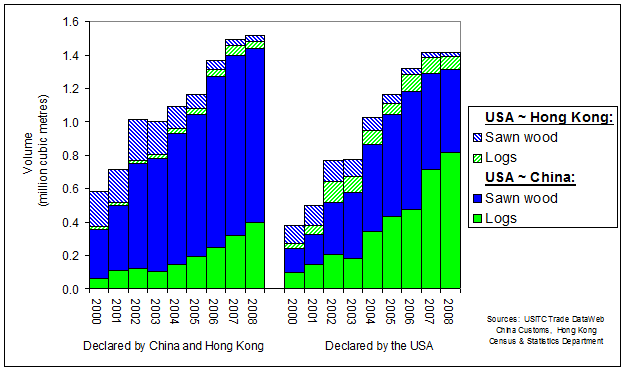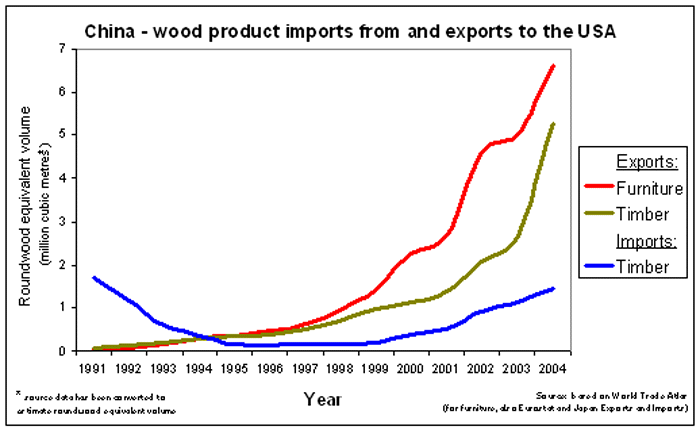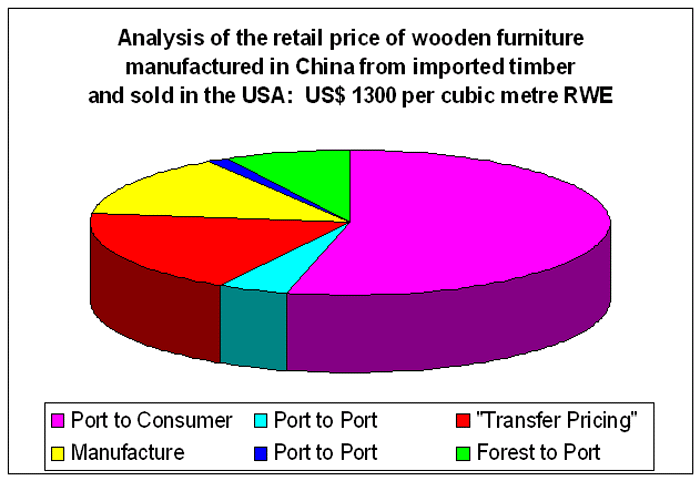|
|
||
|
|
||
|
China's timber trade with the USA |
||
|
|
||
|
Statistics of declared trade between China and the USA indicate that, contrary to received wisdom, most of the wood used in making the wooden furniture which China exports to the USA might not originate from forests in the USA. Recent official reports confirm this. Much of the balance may derive from illegal timber. To guard against this, retailers should consider demanding independently audited chain of custody certificates to show the origin of the timber raw material used in making the wooden furniture which the USA imports from China. It would seem straight forward and not onerous to arrange this - particularly for those US-based enterprises whose imported furniture is based predominantly on timber from US' forests. In addition, the customs services of China and the USA should adopt the procedures of their counterparts in most other major importing countries and declare a physical measure (e.g. weight, but not number or value) of the wooden furniture which they import/export. In not providing such data, China and the USA increase the risk of trade fraud and also add to the difficulties of international timber resource management. It is not clear why trade fora and other interested parties appear to condone this - the roundwood equivalent quantities are large both in absolute terms and in relation to international trade. With international timber resource management in mind, there would be merit in subdividing customs classification codes so as to ensure that products made from rubberwood and the like - for which end-use in furniture or panelling is incidental to the decision to plant - are classified separately. The end-use of at least some, perhaps an increasing amount, of the timber which China imports from the USA takes place within China. It is remarkable that the cost of insurance and freight for the trade in wooden furniture from China to the USA appears to exceed the cost of manufacturing that furniture (including raw materials). The chart above is prepared from data derived from official trade statistics. The unit import price of the EU's imports of wooden furniture from China is used as a proxy for the USA's imports of such furniture. Where appropriate, unit import prices for other timber products have been estimated in a similar manner. Factors to convert derived wood volume to roundwood equivalent volume have been assumed for manufactured items. The ratio between import value and the export value for the declared trade in wooden furniture from China to the USA is rising and considerably greater than the corresponding ratio for trade from China to the EU (mainly the UK), Hong Kong and Japan (the three regions/countries which, with the USA, account for the great majority of China's wooden furniture exports). The ratio would vary with, for example, the quality of wooden furniture imported, the cost of transportation (/availability of containers) and the extent of transfer pricing fraud. The "pie" chart above indicates that this potential fraud might represent a percentage of the retail price (of that wooden furniture when sold in the USA) that is not only high but also rather greater than that of any illegal timber in the furniture. However, this argument is perhaps counterintuitive given not only that the discrepancy is persistent over time and across different types of furniture but also that one might expect reputable authorities in both China and the USA to have taken steps to minimise any transfer pricing fraud (if they had identified the discrepancy). The capacity of China's furniture manufacturers is expanding, some perhaps in a speculative manner, and is likely to exceed demand in export markets given that the authorities in the USA are in the final stages of confirming the imposition of anti-dumping duties. Differences in financial accountability between China and countries to which it exports may make it easier to maintain excess capacity (whether in wooden furniture, plywood or paper manufacture) in China than in those countries, increasing China's likelihood of gaining market share relative to manufacturers in those countries.
|
||
|
Copyright
globaltimber.org.uk
|



